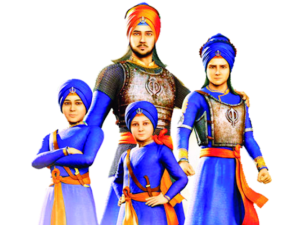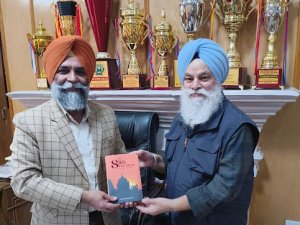Lahore, a prominent city of old Punjab, is now the provincial capital of western Punjab in Pakistan. The city is situated on the left bank of the River Ravi. Sikh history is extensively connected with Lahore. The relations of Guru Nanak Dev Ji, Guru Amar Das Ji, Guru Ram Das Ji, Guru Arjan Dev Ji, Guru Hargobind Sahib, and countless Sikhs are linked to Lahore. The city is home to sacred sites related to the Sikh Gurus and numerous Sikh martyrs.
(Photo Credit: Author) Gurdwara Janam Asthan Guru Ram Das Ji, Lahore. This site is located in the Chuna Mandi Bazaar of Lahore, where Guru Ram Das Ji was born on September 24, 1534. The Guru Sahib spent the first seven years of his childhood here. The ancestral house of Guru Sahib was rather small. Maharaja Ranjit Singh's queen, 'Nakkain,' had a new grand building of the Gurdwara constructed to celebrate the birth of her son, Kharak Singh. The design and architecture of this building bear some resemblance to that of the Darbar Sahib, Amritsar. To the west, there is an open courtyard, and the Nishan Sahib (flagpole) is hoisted towards the southwest corner. Above the main gate of the Gurdwara, the words "Janam Asthan Sri Guru Ram Das Ji" are inscribed in marble. A similar inscription can be found on a wooden board displayed in 'red and blue colors.' The outer walls of the main building also have numerous plaques inscribed with Gurbani and the names of those who contributed to the seva (service). According to one source, the 'Singh Sabha movement' began from this very sacred site. From 1927 to 1947, the entire management was handled by the Shiromani Gurdwara Parbandhak Committee (SGPC). Eight shops are associated with the name of this site. Currently, the management is under the control of the Waqf Department.
Gurdwara Diwan Khana Guru Arjan Dev Ji and Dharamshala Guru Ram Das Ji
This sacred site is also located in the Chuna Mandi Bazaar of Lahore. The ancestors of Guru Ram Das ji were residents of Lahore. Guru ji sent Guru Arjan Dev ji to the wedding of his brother's son and instructed him, “Do not return until you are summoned.” Much time passed. Guru Arjan ji wrote three letters to his father. Two letters did not reach their destination because they fell into the hands of Baba Prithi Chand, and the third letter mentioned the previous two. Inside the courtyard, there is also the Diwan Khana of Guru Arjan Dev Ji . This site is also referred to as Dharamshala Guru Ram Das ji. Maharaja Ranjit Singh had a grand building constructed here, which is registered under card number N-2143 of the Lahore Corporation. From 1927 to 1947, the management was with the SGPC. After 1947, the management passed to the Waqf Department. The Waqf Department has settled people within this sacred site, and thus, the sangat (devotees) cannot perform darshan (viewing). There are four shops and 18 acres of land in the village of Rana Bhatti, Shahdara, associated with the name of the Gurdwara.
Harmandir Sahib, Amritsar
Amritsar is a sacred city for Sikhs and the headquarters of Punjab. Guru Ram Das Ji laid the foundation of this city in 1577 when he initiated the sacred Amritsar Sarovar (tank) on a piece of land. According to one source, this land was purchased by Guru Amar Das ji from the residents of the nearby village ‘Tung.’ However, according to another source, Mughal Emperor Akbar (1542–1605) gifted it to Bibi Bhani, the daughter of Guru Amar Das ji (who was married to Guru Ram Das ji). The settlement around this Sarovar was initially known as Ramdaspur or Chak Ramdas or Chak Guru.
Guru Ram Das Ji encouraged various traders and craftsmen to settle here. The city was further developed by his son, Guru Arjan Dev Ji (1563–1606), who not only completed the Sarovar but also constructed the sacred Harmandir Sahib at its center. Additionally, he constructed two more Sarovars, Santokhsar and Ramsar. It was by the side of Ramsar that Guru Arjan Dev Ji compiled the Adi Granth (later known as Sri Guru Granth Sahib). The 'Sri Guru Granth Sahib' was ceremoniously installed in the Harmandir Sahib on August 16, 1604, making the Sarovar and the Harmandir Sahib a central site of pilgrimage for Sikhs. As pilgrims began arriving from near and far, the town gradually became famous as 'Amritsar.'
Sites in Goindwal Sahib
Goindwal Sahib, situated on the banks of the River Beas, is a Sikh town. It is near Khadur Sahib. Goindwal Sahib is 25 kilometers from Tarn Taran Sahib and 45 kilometers from Amritsar. Guru Amar Das Ji founded this town in 1546 (according to another source, with the assistance of Goinda Marwaha Khatri, who offered this land to Guru Amar Das Ji ). This was the place where the main ancient route (East-West) crossed the River Beas. When the Afghan king Sher Shah Suri rebuilt this primary route, Goindwal became a center of importance.
Guruship Site of Guru Ram Das Ji
This is the place where Guru Ram Das Ji was bestowed with the Guruship. A golden painting here depicts the scene of the Guruship ceremony. This painting was installed in 1920. In this painting, one can witness the presence of Bhai Gurdas Ji, Guru Ram Das Ji, Baba Buddha Ji, Baba Mohri, Baba Mohan, and 22 other prominent Sikhs, to whom Guru Amar Das Ji had granted 22 manjis (preaching seats).
Well of Guru Ram Das Ji
This site is situated to the east of Chubara Sahib Gurdwara. It is the place where Bhai Gurdas Ji merged with the Divine Light. The well constructed by Guru Ram Das ji is also present in the courtyard of this site. All these Gurdwaras are managed by the SGPC under Section 85 of the Act.
Joti Jot Site of the Third Patshahi
Adjacent to the Guruship site is a small marble platform, marking the place where Guru Amar Das Sahib merged with the Divine Light on September 1, 1574, in a small room. Guru Ram Das Sahib also merged with the Divine Light in the same room seven years later.
Bibliography
1. Kahn Singh Nabha - Gur Shabad Ratnakar Mahan Kosh, Delhi, 1990.
2. Iqbal Kesar - Sacred Historical Sites of Sikhs in Pakistan, Lahore, 1998.
3. Baqar, M. - Lahore Past and Present, Lahore, 1952.
4. Harbans Singh (Ed.) - The Encyclopedia of Sikhism, Volume II, Patiala, 1996.
5. Dilgeer, Dr. Harjinder Singh - The Sikh Reference Book, Canada, 1997.
6. Roop Singh - Gurdwaras Gurudham, Amritsar.
7. Khan, Muhammad Wali Ullah Khan - Sikh Shrines in West Pakistan, Karachi, 1962.
8. Tara Singh - Sri Guru Tirath Sangrah, Kanakl, 1975.
9. Thakar Singh, G. - Sri Gurdwara Darshan, Amritsar, 1923.
10. Sarna, Jasbir Singh, Bedi Diljit Singh. - Gurdwara Kosh, Amritsar, 2013







